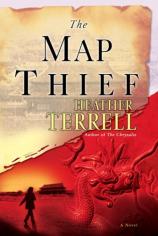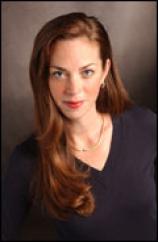Interview: August 1, 2008
August 1, 2008
In Heather Terrell's second novel, THE MAP THIEF, Mara Coyne --- the protagonist of 2007's historical thriller THE CHRYSALIS --- returns with a new art-related mystery, this time involving stolen artifacts from an archaeological dig that may reveal more about history than expected.
In this interview, Terrell describes what inspired the original plot and explains how she first became interested in Chinese Admiral Zheng He, who may have "unofficially discovered" the world decades before the European explorers typically credited for these feats. She also draws parallels between the Ming Dynasty's Forbidden City and present-day Beijing, and shares what she has in store for Mara in her next work, THE BOOK OF KILDARE.
Question: How did the idea for THE MAP THIEF originate?
Heather Terrell: Not long ago, my brother Coley asked me if I’d ever heard of the 15th-century Chinese Admiral Zheng He. When I answered no, he was surprised. After all, he and I have each spent considerable time in China, where the admiral is becoming legendary. Coley explained that, in the early 1400s, Zheng He had assembled a naval fleet so vast and so technologically superior that the Europeans’ ships of the same time period seemed like bath toys in comparison. The presumed prowess of this armada has inspired theories that Zheng He had discovered the world decades before the famed European explorers. I was intrigued. So, I pored over early world maps from this time period, and I learned something curious, a historical mystery of sorts. Several of the very earliest European world maps --- dating from the mid-1400s and beyond --- showed lands and bodies of water that would not be officially “discovered” by the Europeans for decades. My imagination soared. I wondered whether a scrap of evidence of Zheng He’s voyages might have survived, and whether that documentation might have reached the hands of the Europeans --- perhaps a map. Thus, THE MAP THIEF was born.
Q: In THE MAP THIEF, 15th-century Chinese ships discover the new world before the Europeans do, and evidence of their accomplishment reaches the hands of the Europeans before they embark on their own voyages. Could this be true?
HT: I believe that it is possible. With Emperor Yongle on the throne, early 15th-century China had the nautical capacity for the discoveries. Yongle commissioned a navy of thousands of ships --- with five-hundred-foot teak treasure boats at its center --- that had the capacity to remain at sea for long stretches. The Chinese sailors had excellent navigational abilities --- including a sophisticated grasp of astronomy, the ability to calculate latitude, and the use of the compass --- and centuries of experience throughout Asia, the Middle East, and parts of Africa. By way of comparison, the next most powerful fleet of the time was that of the Venetians, who possessed around three hundred galleys at a size of one hundred and fifty feet at the longest.
Most importantly, however, the Chinese had the desire for world exploration of this scale. Yongle had just seized the Dragon Throne after four years of civil war. His father was the first native Chinese emperor after hundreds of years of foreign Mongol rule. Yongle stood on unstable ground internally and externally and wanted to prove to the world that a new political and economic force sat on the Chinese throne. The year he took the throne, 1404, he sent his first message by creating a sumptuous testimony to the primacy and openness of his reign --- the Forbidden City --- and he then undertook a systematic campaign to demonstrate his dominance. This included building his navy and sending it on voyages of discovery and missions to bring all foreign countries into his tribute system.
Q: Are there other explanations for the fact that very early European world maps --- dating from the mid-1400s and beyond --- showed lands and bodies of water that had not been officially “discovered” by the Europeans for decades?
HT: Some have speculated that Arab navigators could have been the original cartographers for the “undiscovered” lands and bodies of water that appear on the early European world maps. The Arab culture teemed with skilled mathematicians, mariners, and navigators with vast experience in the Mediterranean and Indian Oceans. In fact, Vasco da Gama relied on an Arabic pilot to help guide him to Calicut on his first voyage. And, of course, they had a presence on the Silk Road, which may have been the vehicle for transmission of the geographical information.
Q: How might it impact our current political and cultural climate --- particularly with the 2008 Summer Olympics just around the corner --- if we learned that the Chinese had “discovered” the world and then turned inward?
HT: I think that the “discovery” that China charted the world first might cut either way in the current climate. As we all know, with the Olympics, China has unlocked its doors and flung them open wide in the hopes that its cutting-edge, green Olympic Beijing would eradicate the image of xenophobic Communist China. Yet instead of a warm invitation onto the world stage, China is besieged by challenges to its anticipated status. Perhaps if proof existed that China had discovered the world and had the chance to colonize it as the Europeans did, but walked away, the world might be more sympathetic to China’s attempts to solidify their position as a world player. Then again, the world might dig in its heels and say China already had a chance --- and lost it.
Q: Are there parallels between contemporary Beijing and the Forbidden City of the 15th century?
HT: In many ways, the astonishing Olympic Beijing mirrors the historic Beijing that Emperor Yongle created nearly six hundred years ago and sends the very same message to the world: welcome to the progressive new China. Yongle needed to send that message. He was beset by confrontations from foreigners without and challenges from usurpers within and needed to prove that an impressive, forward-thinking force ruled China. Yongle constructed Beijing’s famous Forbidden City as the symbol of his reign and unveiled it to the world on Chinese New Year’s Day, 1421 in an elaborate month-long celebration.
Modern China hopes that Olympic Beijing will demonstrate its rightful world place in much the same manner. Like Yongle, China is besieged by challenges --- by human rights activists, environmentalists, differing governments, and financial competitors. The government wants the avant-garde buildings of Olympic Beijing --- the “Water Cube” and the “Bird’s Nest,” among them --- to replace the old image of China and with that of an open, international player. As in Yongle’s time, the ceremonial unveiling of this message --- the Olympics --- will endeavor to solidify that impression.
Q: THE MAP THIEF focuses on the stories of three primary characters: a Chinese mapmaker, a Portuguese cartographer, and a modern-day lawyer who specializes in retrieving stolen art and artifacts. Why did you decide to layer their stories, and what sort of research was involved?
HT: THE MAP THIEF tells the story of the very first world map and its journey --- and impact --- throughout time. Thus, it seemed fitting that I trace the map’s voyage as it passed from the hands of the early 15th-century Chinese mapmaker who created the map, the late 15th-century Portuguese cartographer and navigator who used it, and the present-day heroine who struggled to locate the map and return it to its rightful owners.
In terms of research, the book delves into Ming Dynasty China (including the Imperial and eunuch courts), the European Age of Discovery, the history of mapmaking, 15th-century oceanic expeditions, and the modern-day world of map thievery and stolen art legislation --- so it involved detailed historical and legal research into all of those areas. I tried to consult original sources whenever possible, such as the journals of Ma Huan, the historian on board one of Zheng He’s journeys, as well as accounts from those on Vasco da Gama’s voyages. In fact, I ordered so many rare, obscure historical texts from my library that the librarians thought I was writing my Ph.D. thesis on eunuchs in Ming Dynasty China, and asked me to lecture about that topic --- before they learned I was writing a novel.
Q: What’s next for Heather Terrell?
HT: As I wrote THE MAP THIEF, I became intrigued by the notion that an object --- be it a piece of artwork or an artifact --- can tell a story, one that answers a historical mystery, as well as divulges something personal and secret about the creator of the object. So, as I cast about through time seeking another object that could tell a multi-layered tale for my third book, I learned about the lost Book of Kildare, an early medieval Irish illuminated manuscript so beautiful it was described as “made by angels.” As I delved into the research, it seemed that this Book might reveal much about the why the Virgin Mary’s portrait first appears in remote, early medieval Ireland and how her image and persona --- indeed women’s roles --- were shaped by society over time. This formed the impetus for my third book, tentatively titled THE BOOK OF KILDARE.




